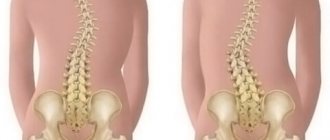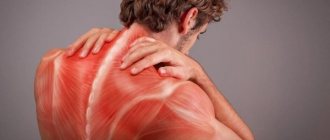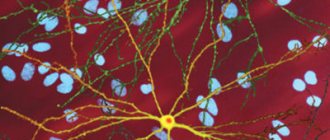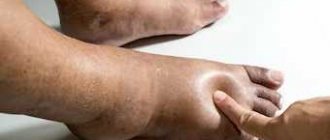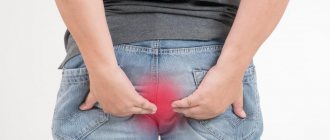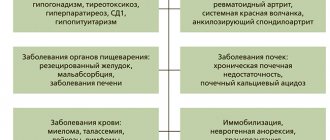Rigidity
Rigidity
- constant presence of muscles in a state of tonic tension, which is characteristic of both agonist and antagonist muscles, and therefore the plastic nature of the increase in muscle tone is manifested. During passive movements in the patient's limbs, the examiner feels an unchanging, viscous, waxy resistance. The patient himself primarily complains of stiffness. With akinetic-rigid syndrome in the initial stage of its development, muscle rigidity in Parkinson's disease is usually asymmetrical and can manifest itself in any one part of the body, but later, as the disease progresses, it becomes more widespread and generalized over time.
The patient's posture changes: the head and torso are tilted forward, with the chin often almost touching the chest, the arms are pressed to the body, bent at the elbow and wrist joints, the fingers are bent at the metacarpophalangeal joints and extended at the interphalangeal joints, while the thumb is in a position opposition to others. An increase in tone in the neck muscles leads to the fact that already at an early stage of the disease, when called, patients tend to turn their whole body or turn their gaze as much as possible, leaving their head motionless.
The main differences between rigidity and spasticity are:
- Distribution of areas of increased muscle tone: rigidity is manifested in both flexor and extensor muscles, but is more pronounced in the flexors of the trunk, and is also significant in the small muscles of the face, tongue and pharynx. Spasticity is combined with paresis or paralysis and, with hemiparesis, tends to form the Wernicke-Mann position (arm bent, leg extended).
- Qualitative indicators of hypertonicity: rigidity - constant resistance to passive movements, “plastic” tone, positive “lead tube” symptom (with passive movements, muscle resistance is uniform, as when bending a lead tube). The spastic state of the muscles is characterized by the recoil symptom and the “jackknife” symptom.
- Rigidity is less associated with increased activity of the arc of segmental reflexes, which is characteristic of spasticity, and is more dependent on the frequency of discharges in motor neurons. In this regard, tendon reflexes do not change with rigidity, but with spasticity they increase; with rigidity, clonus and pathological signs characteristic of spastic paresis do not occur (Babinski's symptom, etc.).
- An obligatory manifestation of rigidity is the “gear wheel” phenomenon; with spastic paresis, this phenomenon does not occur.
How to overcome it
Rigidity, as a personality trait, is not always a pathology. Sometimes this is simply an accentuation of a person’s character, which does not cause discomfort either to him or to those around him.
People with rigidity are good at performing monotonous work that requires attention and precision. Severe behavioral disorders require correction when the harm from rigidity becomes obvious.
The main treatment for this disorder is psychotherapy:
- conversational, allows you to “expose” the problem and comprehend it and often “devalue” the objects on which you get “stuck”;
- rational - affective, leading, with the help of arguments and a chain of logical thoughts, to an awareness of the adverse impact of rigidity on the patient’s life;
- psychoanalysis, which allows you to “legalize” the secrets of the subconscious, feel hidden negative emotions and get rid of them;
- communication trainings that allow you to see yourself from the outside and understand your role in society;
- art therapy promotes the implementation of the positive aspects of rigidity in practical actions.
Systematic exercises help develop the plasticity of mental processes and improve their adaptive capabilities.
Drug treatment for this disorder is not used, since the predicted effect of it is very doubtful.
Symptoms of Muscle Stiffness
In humans, with damage and disruption of the central nervous system and pathological irritation of peripheral nerves, various manifestations of muscle rigidity may be observed. Thus, in case of poisoning with certain poisons, diseases of the nervous system, as well as under the influence of hypnosis, a state of plastic tone occurs, characterized by the fact that the muscles become waxy; In this case, it is easy to give the limbs any position that they hold for a long time without changing. The appearance of plastic muscle tone is characteristic of a special condition of the nervous system, called catalepsy, or waxy rigidity.
With parkinsonism, the severity of hypokinesia and muscle rigidity may depend to a certain extent on the general condition of the patient. At rest, hypokinesia and muscle rigidity are more pronounced; with slow passive movements, some weakening of rigidity is sometimes observed. Hypokinesia and rigidity are largely influenced by the patient’s mental state, especially negative emotions, which sometimes sharply increase muscle tone. However, in the morning, after sleep, the severity of both components of akinetic-rigid syndrome can significantly decrease.
This also sometimes manifests itself in some extreme situations (short-term manifestations of paradoxical kinesia). A slight decrease in the severity of muscle rigidity is also noted during the patient’s stay in a warm bath or during therapeutic massage. All this allows us to judge that the functional defect in akinesia and rigidity is variable within certain limits, in some cases it can fluctuate in severity: from a state of general immobility to episodes of almost complete restoration of the functional capabilities of the motor sphere.
Causes
Doctors at the Yusupov Hospital identify the cause of muscle rigidity and use innovative methods for treating diseases of the central and peripheral nervous system, extrapyramidal disorders, the manifestation of which is muscle rigidity. Muscle stiffness, or muscle tension, in particular is a symptom of Parkinson's disease.
Stiff neck
Neck stiffness is a pathological condition that occurs as a result of excessively frequent sending of impulses from the brain, which increases the tone of the muscles, turning into a state of stiffness (rigidity). Stiff neck muscles indicate the presence of meningitis or other central nervous system lesions.
Causes of a stiff neck
The main cause of a stiff neck is meningococcal infection, which comes in various types. Purulent meningitis is a group of diseases of the central nervous system, characterized by the occurrence of general infectious, cerebral, meningeal syndromes and changes in the cerebral fluid with the presence of pus in the latter. Less commonly, staphylococci, Escherichia, Pseudomonas aeruginosa, Salmonella, Klebsiella, Listeria and other bacteria are involved in the development of the disease.
The cause of meningococcal meningitis is gram-negative meningococcus. Any infected person plays the role of a source of infection, and it is transmitted by airborne droplets. At the initial stage, there is an increase in temperature, chills, and pronounced symptoms of intoxication (lethargy, adynamia, refusal to eat and drink, headaches). Vomiting appears not related to food intake.
Pneumococcal meningitis is caused by Streptococcus pneumonie. The source of infection is patients with pneumococcal infection, as well as carriers of pneumococcus. The disease is characterized by an acute onset: most often in the first hour there is a sharp increase in temperature to 39-40 ° C and rapidly increasing signs of intoxication. Then symptoms appear that resemble meningococcal infection. On the second or third day, meningeal symptoms appear in a distinct form, in particular, stiffness of the neck muscles is noted. With timely and adequate treatment, the patient’s condition improves significantly after the first week.
Other causes of a stiff neck
- Summer-autumn mosquito encephalitis (Japanese encephalitis)
- Cervical myelopathy (spinal compression)
- Cervical spondylosis
A stiff neck is a symptom of one of these severe forms when it occurs unexpectedly, with accompanying symptoms such as nausea or vomiting, fever, headache, drowsiness, confusion, depression, or a seizure. Pain appears on the back of the neck in the middle part and is caused by bending forward or backward.
Treatment of a stiff neck
Treatment for a stiff neck is aimed at addressing the underlying cause. Of the etiotropic and pathogenetic measures, intensive penicillin therapy is effective. In addition, semisynthetic penicillins (oxacillin, ampicillin) are effective methods. The body is detoxified, treated with vitamins and oxygen. When symptoms of brain swelling and edema appear, dehydration therapy is carried out, which helps remove excess fluid from the body. In this case, the use of corticosteroid drugs is practiced. For seizures, phenobarbital is prescribed.
What it is?
The concept of “ rigidity ” is used in many scientific fields: medicine, mechanical engineering, nanotechnology. Translated from Latin, it means “hardness”, “immobility”, “stiffness”. Rigidity is, in psychology, a specific property of a person’s personality, characterized by the absence or extremely slow adaptation of behavioral reactions (low adaptation) to changing environmental conditions.
This personal quality can be expressed moderately, or it can become dominant in a person’s mental activity.
In the first case, rigidity does not cause any particular difficulties for people, but in the second, it negatively affects the lives of patients, their development seems to be suspended and their perception of the world is limited to the framework of internal experiences and reflections on simple and complex everyday situations or relationships with people around them.
The main distinguishing features of a rigid personality are:
- patterned and stereotyped thinking, emotional reactions or actions;
- denial of everything new, fear of changes and changes in life;
- irresistible stubbornness (no amount of arguments from others will force such people to abandon their views);
- high level of emotional excitability, suspiciousness, anxiety;
- prolonged “obsession” with your thoughts and feelings.
At the same time, such people, as a rule, retain logical thinking, purposefulness and determination, they have good self-esteem and are not prone to prolonged depression, antisocial or deviant behavior.
Spasticity and rigidity
Zefirov A.L., Alatyrev V.I.
The role of various hierarchical levels of movement control clearly appears in cases of damage to the central nervous system. One of the main dysfunctions of the musculoskeletal system in humans is spasticity. The medical dictionary defines spasticity as a state of muscle hypertonicity with increased tendon reflex. In a typical clinical examination, spasticity has the following features:
1. The muscle stretch reflex, which is normally hidden, becomes obvious.
2. Tendon reflex thresholds decrease.
3. The response of the muscle when the tendon is struck increases.
4. To a blow to the tendon of one muscle, not only it, but also the neighboring ones respond.
5. Tonic stretch reflexes (i.e. resistance to passive movement of the limb) also increase.
6. Clonus may be caused.
Classic views on the pathogenesis of spasticity were developed by Sherrington, who studied decerebrate rigidity, which in cats is caused by the intersection of the brain stem at the level between the superior and inferior colliculi. The operation has an immediate effect, noticeable stiffness (constant tension) occurs in those muscles that are anti-gravity. As a result, the animal acquires a characteristic pose with tense, elongated limbs, raised head and tail. All spontaneous motor activity is suppressed. Since the pons, medulla oblongata, and spinal cord are located caudal to the intersection, breathing and cardiovascular reflexes are preserved. If a decerebrate animal is cared for and fed, it will survive and rigidity will remain throughout its later life.
An important fact is that motor disorders in decerebrate animals are very similar to spasticity in humans. Common to decerebrate rigidity and spasticity is hyperactivity of the phasic and tonic stretch and clonus reflexes. Therefore, decerebrate animals are a useful experimental model, and knowledge of the neural mechanisms underlying decerebrate rigidity should provide insight into the physiology of spasticity.
The neurophysiological mechanisms of rigidity are revealed in the following series of experiments. These are, first of all, experiments with the intersection of the brain stem at various levels. To induce rigidity, the incision must be caudal to the red nucleus. In fact, the intersection of the brain at any level between the red and vestibular nuclei leads to rigidity. Complete transection of the brainstem caudal to the vestibular nucleus or destruction of the vestibular nucleus relieves rigidity. From these observations it was concluded that the vestibular nuclei have a facilitating (exciting) effect on underlying motor neurons.
The next important finding is that decerebrate rigidity is mediated reflexively. Sherrington also showed that unilateral transection of the dorsal roots eliminates muscle rigidity on the side of the rhizotomy. Therefore, the presence of rigidity depends on the integrity of the reflex arc. It further turned out that decerebrate rigidity requires the participation of muscle afferents, or more precisely muscle proprioceptors.
The structural and functional features of muscle spindles were not yet known in Sherrington's time. Only after 1945 did physiologists begin to intensively study the gamma motor innervation system of muscle spindles. In normal motor activity, the activity of alpha and gamma motor neurons is coupled. Impulses descending from the centers of the brain along independent parallel pathways excite alpha and gamma motor neurons in appropriate proportions and normally produce smooth coordinated movements.
When the brain is damaged, this balance changes, which can lead to hyperactivity of gamma motor neurons. Their unnaturally high firing rate causes excessive firing in the primary afferents. Ia afferents monosynaptically excite homonymous and synergistic alpha motor neurons, ultimately resulting in hypertonicity or spasticity of skeletal muscles. Spasticity that is reduced or eliminated by disruption of the gamma spindle loop is known as “gamma rigidity.” Most clinical cases of spasticity have a significant gamma component.
Despite the widespread occurrence of gamma rigidity, not all spasticity is mediated exclusively through the gamma spindle loop. Under some circumstances, brain damage can “release” alpha motor neurons from supraspinal inhibitory control instead of gamma motor neurons. Under these conditions, it is the alpha motor neurons that are the site of abnormal hyperactivity and disruption of the gamma spindle loop will not lead to a decrease in spasticity. Spasticity that persists when the gamma loop is ruptured is referred to as “alpha rigidity.”
Alpha-stiffness can be caused in a cat by ligating the carotid and basilar arteries. This procedure causes ischemia and death of both cerebellar and medullary neurons. Animals decerebrated by the ischemic method have movement disorders similar to those that occur with intertubercular transection of the brainstem, but this rigidity does not disappear with transection of the dorsal roots.
Alpha rigidity can be demonstrated in another way. For example, in a classic decerebrate preparation, rigidity can be eliminated by transection of the dorsal roots and then reintroduced by stimulation of the vestibular nucleus. This observation indicates that the vestibulospinal tract transmits influences that facilitate alpha motor neurons.
Upon further research, it was found that some areas of the brain play a facilitative role, while others act as suppressors. These concepts were established in experiments performed on animals in which the cortex around the cruciate sulcus was removed. This operation causes temporary rigidity with motor impairments similar to those seen in classic decerebrate rigidity.
Electrical stimulation of certain areas of the brain in these decorticated animals increased rigidity. Stimulation of other zones caused the opposite effect and these zones were designated as suppressor. Facilitating zones can exert their excitatory effect directly on the spinal cord through descending pathways, such as the vestibulospinal tract and rubro-spinal tract, or indirectly through pathways from the lateral reticular formation, i.e. through the lateral reticulospinal tract.
The lateral reticular formation is a pencil-shaped formation that extends through the medulla oblongata up to the thalamus. The input to the reticular formation is established for most sensory systems. Its output signals are directed upward to the cerebral hemispheres via the ascending pathways and down to the spinal motor neurons via the descending pathways, where they are the main source of facilitation of motor neurons, especially gamma motor neurons. The cells of the lateral reticular formation are in a state of constant activity. As a consequence, they are a source of continuous facilitation of segmental motor neurons.
Unlike facilitatory zones, all suppressor zones do not act directly on the spinal cord, but only through neurons of the medial reticular formation. The medial and lateral reticular formations are not similar to each other both anatomically and functionally. The medial reticular formation is a group of clusters of nerve cells scattered throughout the brain stem. The medial reticular formation projects to the spinal cord as the main source of supraspinal inhibition of segmental motor neurons; it is the common final pathway of the suppressor zones of the brain. Neurons of the medial reticular formation, unlike lateral reticular neurons, do not have background activity. They are triggered and controlled by impulses from suppressor zones and only thanks to this are they able to exert their inhibitory effect on segmental motor neurons.
When the suppressor zones are damaged, the medial reticular neurons do not function and the spinal cord motor neurons are “freed” from the inhibition normally imposed by the suppressor zones. This elimination of descending inhibition leads to an imbalance in the control system. The effect of facilitatory impulses is no longer offset by competing inhibitory impulses. The consequence of this imbalance is rigidity. Elimination of one of the suppressor zones causes transient rigidity; elimination of two or more suppressor zones causes long-term rigidity. The latter manifests itself in the form of a triad of motor symptoms that make it possible to determine the presence of spasticity. These symptoms are: hyperactive phasic stretch reflexes, hyperactive tonic stretch reflexes, and clonus.
Based on the above, one gets the idea that spasticity in humans is equivalent to rigidity in animals. Still, the concepts of spasticity and rigidity are not synonymous. The main symptom of spasticity will be an increase in muscle resistance to stretching compared to normal. The amount of resistance depends on the speed of movement. In spastic patients there may be a situation in which slowly produced passive movement does not produce resistance. In rigid muscles, tension is always present, both in the initial state and when they are stretched. A manifestation of spasticity in this case will be that the contraction of tense muscles with increasing stretching speed increases too quickly compared to the norm.
Experimental rigidity can be obtained in animals without the involvement of the brain. Such spinal rigidity with severe symptoms of spasticity (gamma rigidity) and without them (alpha rigidity) develops after temporary ischemia of the spinal cord. In the vast majority of cases, post-ischemic rigidity, if it is not pure alpha-rigidity, is of a mixed nature.
In spinal dogs, another type of rigidity is easily caused, namely prolonged tension of the abdominal and paraspinal muscles due to intense chemical irritation of the peritoneum. Muscle tension during nociceptive afferent influences is often encountered in human clinical practice and is, on the one hand, a protective reflex, and on the other, a diagnostically important symptom. The discovery of the mechanisms of protective reflexes and their classification are therefore of great practical importance.
The occurrence of protective reflexes is not associated with damage to the central nervous system. Of decisive importance here is pathologically enhanced afferent impulses, which ultimately leads to an imbalance of excitatory and inhibitory influences on motor neurons. The process can develop within the spinal level, but can also be carried out with the participation of other hierarchical levels, but only of a low order. Thus, with the predominance of excitatory influences on motor neurons, spinal or supraspinal muscle rigidity occurs in the form of an exciting tonic protective reflex.
The mechanisms of protective tension in the muscles of the abdominal wall and paraspinal muscles under intense visceral influences have been developed by us for a long time. The results can be presented briefly as follows.
Under normal conditions, impulses from the receptors of internal organs do not reach motor neurons, or, in any case, they do not cause excitation of motor neurons. On the polysynaptic path of these impulses, according to Sherrington’s figurative expression, “resistance is inserted.” This resistance is nothing more than supraspinal and intraspinal inhibition of various natures (mainly postsynaptic in nature).
With intense irritation of the peritoneum, flows of nociceptive afferent impulses cause a restructuring of the functional relationships of the nerve centers in such a way that the supraspinal and intraspinal inhibition of the transmission of visceral signals to motor neurons is eliminated. An imbalance occurs in the form of an excess of excitatory influences and a deficiency of inhibitory influences. The consequence of this is the excitation of first low-threshold small (according to Henneman’s rule) and then large alpha motor neurons.
The resulting long-term muscle tension could therefore be considered an example of alpha rigidity. However, this is not quite true. With pathologically enhanced, nociceptive afferent impulses, a certain set of interneurons associated with these afferents becomes a hyperactive neural generator. Not only alpha, but also gamma motor neurons fall under the influence of this generator. The latter activate the receptor formations of muscle spindles. This generates streams of impulses in Ia afferents, which monosynaptically excite homonymous alpha motor neurons. Through the gamma loop, the rhythmically discharged “tonic” alpha motor neurons are primarily activated.
Thus, with protective tension in the muscles of visceral origin, a reflex arc functions, which includes visceral afferents, associated interneurons and alpha, gamma efferents. Here, static gamma fibers are assumed to be crucial. Due to the involvement of the gamma loop, the mechanism of protective muscle tension has a kind of “circle of support”, starting from the gamma motor neurons and ending at the alpha motor neurons, i.e. This is one of the cases of alpha, gamma coactivation. Therefore, we consider protective muscle tension as an example of mixed rigidity.
Another interesting physiological phenomenon is involved in supporting this rigidity. The fact is that a hyperactive neural generator causes hyperactivation of gamma motor neurons, as a result of which the spindles are also hyperactivated. The impulse in Ia afferents reaches high frequencies (200-300 impulses/s) and creates conditions for the occurrence of the phenomenon of post-tetanic potentiation (PTP) at the synapses of alpha motor neurons. PTP means increased productivity of synaptic transmission, and in “tonic” motor neurons, PTP is better expressed than in “phasic” ones. This mechanism, along with others we described earlier, ensures the intensity and duration of protective muscle tension.
The analysis given here of such movement control disorders as spasticity and rigidity clearly shows that pathological reactions are based on physiological mechanisms and the line between normal and pathological is very arbitrary.

